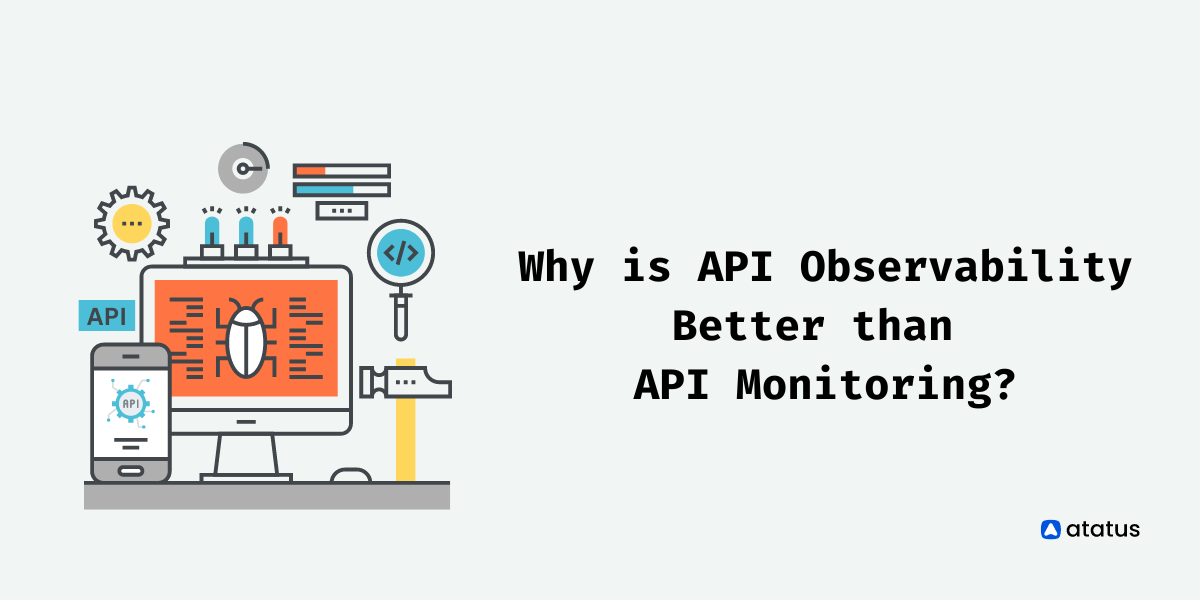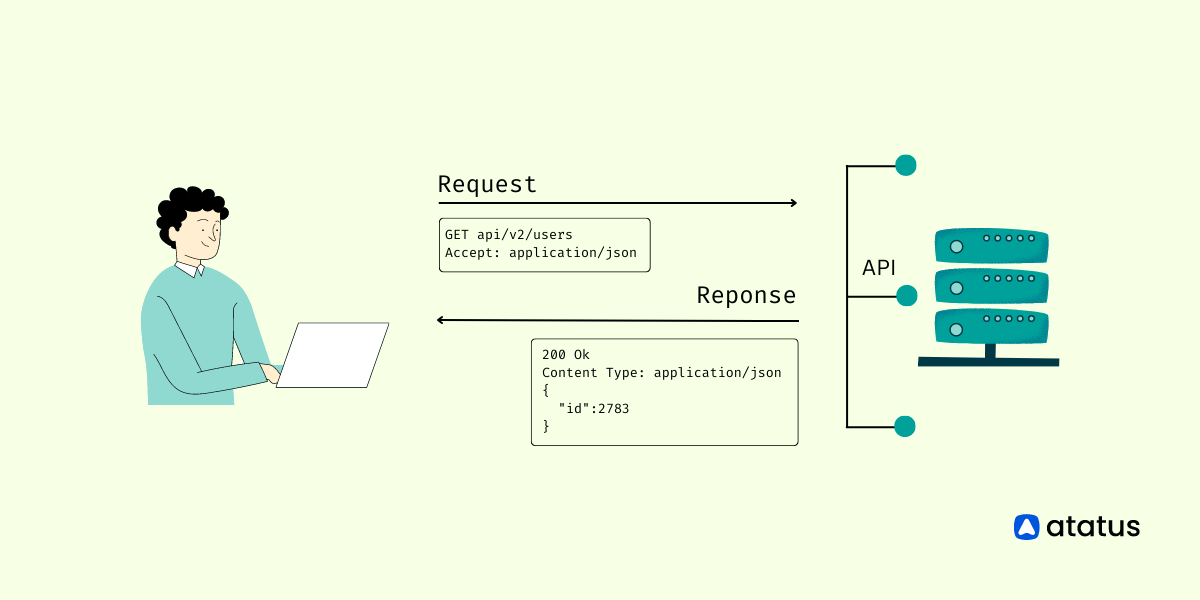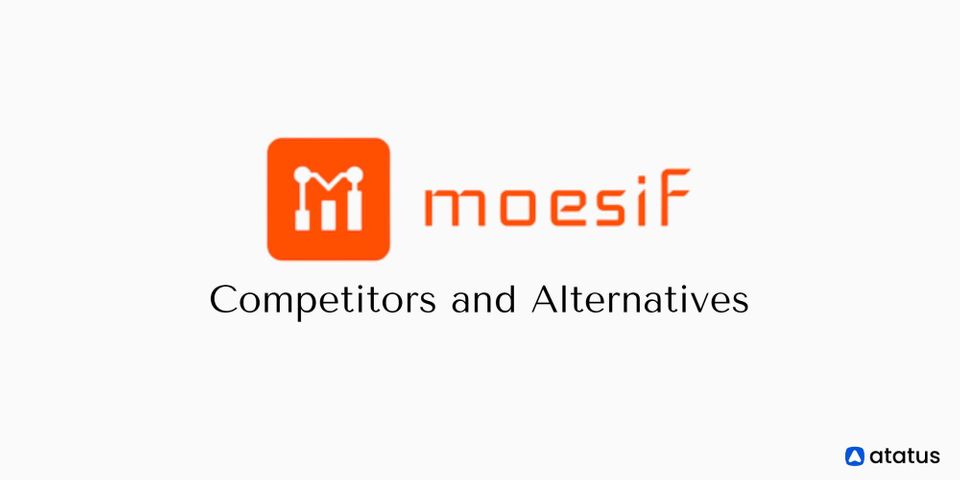Why is API Observability Better than API Monitoring?
In recent years, there has been a rapid expansion in the API market. Today, every piece of software is either an API or uses one. They are now a crucial component of the modern digital economy. As a result, it is becoming increasingly important to grasp how to examine them carefully.
In this article, we'll discuss the definitions of API observability and API monitoring as well as how API observability is better than API monitoring.
We will cover the following:
- Introduction
- What is API Monitoring?
- What is API Observability?
- Pillars of API Observability
- Uses Cases for API Observability
Introduction
Since many years ago, businesses have used the standard concept of API monitoring to assess the performance and quality of APIs. An API monitoring tool starts making API calls to the endpoints you specify, then logs the results. A slack alert can be created on a 500 error or timeout, for example, as additional checks.
Either a trigger (such as when a new version is released by your CI/CD pipeline) or a regular schedule can be used to start the test (such as every 1 minute). Simple health and uptime checks are examples of simple API monitoring tests.
More complex tests involve making a large list of API calls and comparing the results to predetermined status codes, body fields, and other criteria.
While API monitoring gives you the ability to check for uptime and respond appropriately if your API times out or returns a 500 error, it also has limitations because it is a black-box type of monitoring with pre-created assertion checks.
Since the test or probe is already known in advance, API monitoring cannot provide arbitrary answers about how your API is acting. Instead, API monitoring cannot monitor actual client API activity; it can only monitor the traffic it generates.
To prevent API threats, address customer complaints, and understand API usage, there are new requirements to research and identify unknown unknowns as more APIs are made available on the internet. These demands prompted the development of API observability.
API observability, a type of white-box monitoring different from black-box testing and monitoring, calls for an agent or SDK to passively log API activity to an observability service. The application itself could be used to collect the data, or a different point may be added, such as an API gateway like Kong or NGINX.
What is API Monitoring?
Application Programming Interfaces (API) are monitored to get visibility into their performance, availability, and functional accuracy. This process is known as API monitoring.
You can assess the performance of your applications and enhance underperforming APIs with the aid of solutions for API monitoring. They give metrics of how much time is spent processing a transaction, how frequently it is called, from where it is called, and how long it takes to complete a procedure.
APIs are frequently the foundational elements employed in digital transformation initiatives to propel enterprises into the contemporary digital era. As a result, the majority of applications rely on APIs for crucial business interactions. Organizations have performance blindspots when they don't fully understand what happens when each API endpoint or a series of APIs is called.
Imagine a continuous cycle of software development, testing, deployment, and monitoring. As engineering organizations adopt Agile practices and other cutting-edge methods for software development, testing, and deployment, it is essential that monitoring turns into a necessary extension of that continuous integration cycle.
Maintaining monitoring scripts with the appropriate and most recent versions of the functional tests to ensure ongoing availability for service users is essential to delivering the experience envisioned in the original design.
Your app's performance will suffer, and the end-user experience will suffer, if the APIs you utilize to deliver services for it is either unavailable, not functioning properly, or not responsive.
In a nutshell, API monitoring is a technique that enables teams to see and understand the condition of their APIs, or even systems, depending on where it's being used. In other words, gathering predefined sets of metrics or logs is the foundation of monitoring.
While traditional API monitoring gives you the ability to examine your API status, errors, and timeouts, it also comes with inherent limitations because it is a black-box method of monitoring.
Black-box Monitoring
Black-box monitoring is a type of monitoring where users' perspectives are used to verify externally apparent behavior. In other words, since it relies on presuming that something can break before it does, it's not all that different from having to predict which components of your API may lead to issues.
The drawback of this is that you must manually write the checks you need in advance, and your API monitoring will ultimately only be able to check on the traffic that your tests generate, not API traffic from actual customers.

What is API Observability?
API observability is a way to monitor the performance of your APIs. API observability allows you to monitor what your API is doing and can show you how your application's various parts—such as the server and database—interact with one another.
As a method of direct observation of a system, API observability, which includes logging, monitoring, and tracing, requires an agent or SDK to passively log API activity. This data can be gathered within the application or at several locations, such as an API gateway. Your business and engineering teams can benefit from in-depth knowledge about how your APIs are utilized due to API observability.
You can use API observability to monitor code to make sure that all expected calls are being made as planned. This implies that you'll be aware of any unusual behavior in one part of the code right away and be able to resolve it before users become aware of any problems, such as some unexpected data being returned from an API call.
API observability, on the other hand, focuses on making our API observable rather than limiting our ability to troubleshoot to what we have planned to log or monitor in advance. API observability is a type of white-box monitoring, in contrast to traditional monitoring.
White-box Monitoring
It takes an agent or SDK to passively log API traffic to an observability service to enable teams to actively debug their system. The concept of a white-box inspires a sense of transparency; it is a type of monitoring based on metrics exposed by the internals of the system.
The core of observability can be divided into three main categories: structured metrics, logs, and traces. Observability is focused on discovering traits and patterns that are not previously established.

Pillars of API Observability
There are a few pillars that provide API observability, including:
- API Logs
- API Metrics
- API Analytics
- API Traces
#1 API Logs
Real-time API call inspection is possible using an API observability platform like APIToolkit for auditing and debugging. The precise calls that your APIs make at any given moment are displayed to you in API logs.
Contrary to typical logging, an API has an inherent structure, so API logs can be utilized to generate aggregations and analytics while keeping context. Even though API calls may contain numerous HTTP headers, body keys, and attributes. Since this requires a thorough scan of your data store, your API observability tool should be able to filter and aggregate them instead.
It's vital to remember that the GDPR and CCPA require new processes for areas like API logs, which are used throughout the organization by both business and security teams.
API logs can no longer be simply dumped into a log management plan. Instead, API businesses require a method for exporting and erasing (or anonymizing) all the related logs and events that are unique to a single client.
As a result, API logs must be connected to a persistent user identity (and not just API keys that are rotated).
#2 API Metrics
Companies can better assess API operational performance and its value to the company by using API metrics. Business users will be interested in metrics showing the performance of the API platform, such as the number of API calls, while enterprise architects will be more interested in metrics showing the impact of APIs on business outcomes (such as how many new customers have signed up through an API channel).
Only single-value metrics, such as requests per minute, can be monitored by some metrics tracking solutions. The ability to respond to any query about your API and services without having to predetermine which metrics should be tracked is a fundamental component of observability, though.
High-cardinality, high-dimension measurements, and data storage are useful in this situation because they allow for quick slicing and dicing to explore and answer unknown unknowns.
#3 API Analytics
API analytics is focused on responding to queries about products and businesses, as opposed to API metrics and logs which are focused on engineering-specific questions.
In short, API analytics is the fusion of API metrics with information about your customers' demographics and API usage patterns. To map out the customer journey, API analytics solutions frequently draw data from other systems, such as your CRM or marketing automation platforms.
API Analytics & Monitoring tracks customer and product KPIs including engagement, retention, and developer conversion in addition to engineering-focused metrics like performance and uptime.
#4 API Traces
Since APIs are transactional in nature, they carry timing information on when the request was made and how long it takes the service to answer, among other times.
It is simple to understand from API traces how long various services take to react and where timing issues may occur. With the aid of traces, you can further investigate which logs to examine for a specific session or associated group of API requests.
Uses Cases for API Observability
These are the use cases of API observability which explains why it is better than API monitoring:
#1 Monitor Customer Experience
API observability allows you to profile various end-to-end processes and identify potential trouble spots because it can track every contact a user or customer has with your API. The majority of teams that offer APIs don't have complete control over how their users will use the API.
These customers may be from a separate division, product, or company entirely within a huge organization. Developers often assume that customers would use their products in a particular way yet working with APIs can be difficult or problematic.
For instance, you might have API users who ignore your suggestions for filtering and pagination, resulting in an excessive amount of data being probed. API observability aims to proactively identify these unknown unknowns and fix them, whether the issue is with your own code or the code of an API consumer.
#2 Recognize Customer API Usage
Not simply for the sake of constructing things, but also for the consumers or users of the API, businesses build APIs. This is another use case for User Behavior Analytics (UBA) for APIs, and it shares some requirements with API security in that it calls for a method to link API calls to specific customers and their sales.
The product organization, as well as the sales and growth teams, frequently seek out API analytics to monitor pilot usage, trials, and expansion potential.
Twilio wasn't valued at $500 million until 2015 at the earliest. Now worth $30 billion, astonishingly 83% of all HTTP traffic, according to Akamai, originates from API calls. APIs are now a significant business driver rather than just a "backend technology."
#3 Investigate API Issues
An API observability tool logs everything that occurs over the API, allowing you to investigate previously unrecognized unknowns like a potential customer problem. To find out what happened, you don't need to prepare for a test before.
Many different API errors might occur. Some are simpler to analyze, such as missing an API key or HTTP header, but others can be much more complicated, requiring monitoring the timing and history of API requests.
#4 Identify and Defend Against API Risks
In addition to monitoring what occurs through the API, a well-designed API observability platform also keeps track of the individuals who are making those requests, enabling advanced User Behavior Analytics (UBA) and User and Entity Behavior Analytics (UEBA). You can spot suspect users who might be using your API for scraping or accessing unwanted data by watching complex user flows.
An API offers unfiltered access to your data, unlike a web application, which can use tools like Capctha and browser fingerprinting. It can be incredibly challenging to distinguish between legitimate API calls and fraudulent ones because some APIs may even allow programmatic consumer access. Due to this, APIs cannot be protected by conventional rule-based Web Application Firewalls (WAFs), such as ModSecurity.
Instead, new API observability solutions that prioritize the needs of the user can find unknown unknowns utilizing sophisticated anomaly detection.
Conclusion
There are APIs everywhere these days, and their relevance within the software ecosystem is continuously increasing. API monitoring, though, is limited in what it can accomplish for you. Consider employing an API observability strategy to your API if your team must respond to ad hoc questions from data-driven engineering and business teams.
An API observability platform like Atatus is what you need if you want to ship APIs quickly and confidently.
Atatus API Monitoring and Observability
Atatus provides Powerful API Observability to help you debug and prevent API issues. It monitors the consumer experience and is notified when abnormalities or issues arise. You can deeply understand who is using your APIs, how they are used, and the payloads they are sending.

Atatus's user-centric API observability tracks how your actual customers experience your APIs and applications. Customers may easily get metrics on their quota usage, SLAs, and more.
It monitors the functionality, availability, and performance data of your internal, external, and third-party APIs to see how your actual users interact with the API in your application. It also validates rest APIs and keeps track of metrics like latency, response time, and other performance indicators to ensure your application runs smoothly.
#1 Solution for Logs, Traces & Metrics
APM
Kubernetes
Logs
Synthetics
RUM
Serverless
Security
More





